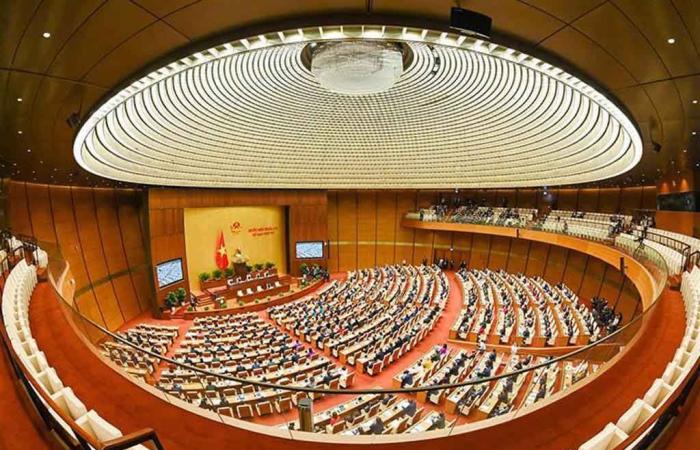Hanoi.- Reflection of a stage of deep structural and organizational transformation, of the institutional framework and the strategic thinking of national development, the IX session of the National Assembly (Parliament) will be decisive for the Vietnam that comes.
A Vietnam determined to enter what its greatest authorities define as a new era of development, prosperity and strength, which allows you to successfully build an increasingly rich, democratic, prosperous, civilized and happy country.
One era for which two fundamental strategic objectives are raised: becoming a developing nation with a modern industry and medium-high income by 2030, and climbing to a developed and high income level, with socialist guidance, by 2045.
Hence the historical importance and importance of the coming session, scheduled in two stages from May 5 to June 28 and which, according to the president of the National Vietnamese Assembly, Tran thanh Man, will have the greatest workload since the beginning of the current mandate.
The Legislative must approve 31 laws and eight resolutions, including the modification and amendment of the current Constitution of 2013, an essential element to carry out the accelerated process of rationalization and reorganization of the ongoing political system.
As explained by Thanh Man himself, the review of the Magna Carta will have a limited reach, as it would affect about eight articles of the 120 that contains the current law of laws, and will cover two large groups of content.
The first refers to the provisions related to the Forest Patria and socio -political organizations, in order to rationalize the organizational apparatus, while the second group concerns the provisions that will allow implementing the administration model in just two levels: provincial and local.
As planned, the review of the Constitution and laws and related resolutions must be completed before June 30 and enter into force as of July 1. In addition, while the Parliament meets, a popular consultation on constitutional reform will be held from May 6 to June 5.
From the Foundation of the Democratic Republic of Vietnam the country adopted five magna letters: those of 1946, 1959, 1980, 1992 and 2013.
The proposal to reform the Law of Laws, which is undertaken more than a decade after the previous one, responds to the need to update the legal basis of the country before the new context and establish a constitutional framework that allows a more efficient organization of the state apparatus and other structural reforms.
According to Thanh Man, the rationalization of the organizational structure must be carried out as a revolution, ensuring that the device complies with the principles of “compact, efficient, functional and effective.”
Two plus two is not four
The fusion of provinces that Vietnam will undertake as part of the reorganization policy of the administrative units aims to create new dynamics, potentialities and new development spaces, the Secretary General of the Communist Party (PCV), to LAM, recently said.
“It is not simply” two plus two is equal to four “, but” two plus two is greater than four, “said the partisan leader in a meeting with veteran former revolutionary leaders and people with merits in the southern Ho Chi Minh City.
To Lam stressed that the reorganization policy of the administrative and construction units of a two -level local government was carefully discussed and evaluated, many aspects were considered and a high consensus on its implementation was achieved.
“People from all over the country agreed to support him and considered him a true revolution,” he said.
The announced change involves moving from the 57 provinces and six cities under central administration (Hanoi, Ho Chi Minh City, Da Nang, Hue, Hai Phong and Can Tho) currently existing to only 34.
Only 11 territories remain unchanged: the cities of Hanoi and Hue and the provinces of Lai Chau, well, are the Lang Son, Quang Ninh, Thanh Hoa, Nghe An, Ha Tinh and Cao Bang.
In the remaining cases two or three provinces are merged to give rise to a new entity whose political-administrative center has already been defined.
This process seeks to redesign the development space with a national vision by 2050: create new growth engines, economic corridors, interconnected dynamic poles, and thus raise the competitiveness of the country.
In addition, it is intended to take advantage of natural resources – land, water, forests, minerals – and maritime, underground and aerial spaces.
On the other hand, it is expected that after territorial reorganization the number of administrative units at the provincial level of 60 to 70 percent in the communal will be reduced compared to the present, while the district instance will disappear completely.
Specialists estimate that this restructuring could be a saving of approximately 11.2 billion dollars a year, which is equivalent to 3.8 percent of the national gross domestic product (GDP).
Compact government
The restructuring of the government apparatus also seeks to adequately organize multisectoral and multidisciplinary ministries, to guarantee the rationalization and reduction of institutions, improve efficiency and meet the conditions to build and improve the Socialist State of Vietnam’s Law in the New Age.
Thus, the Vietnamese Government – which will be composed of 25 members, including Prime Minister and Seven Deputy Prime Ministers – will adopt a more efficient organizational structure, with only 14 ministries and three ministerial level agencies.
The purpose of this structural reform, official sources said, is to eliminate the bureaucracy by dissolving 13 general departments, 519 departments, 219 divisions, three thousand 303 sub-department and 203 public service units, which represents a reduction in the workforce of around 20 percent.
A comment about this topic published by the newspaper Hanoi Moi stressed that “rationalizing the device is an imperative of life, which arises from the practical requirements of a Vietnamese economy in rapid transformation and the desire to build a strong and modern country.”
This is not only an important policy, but also an urgent requirement to release resources, improve labor productivity and create a basis for the sustainable development of the country in the new era, he added.
According to the source, Vietnam’s current political system is large. The total number of public officials and employees at the end of 2022 exceeded 2.2 million people, which represents an important part of the dynamics of the workforce.
“This is a heavy burden for the state budget, especially for recurrent expenses. The annual recurrent expenditure rate in Vietnam usually represents about 70 percent of the total expenditure of the state budget,” and much is used to maintain the operation of the administrative apparatus, the newspaper argued.
Taken from the Latin Press
Share on social networks






